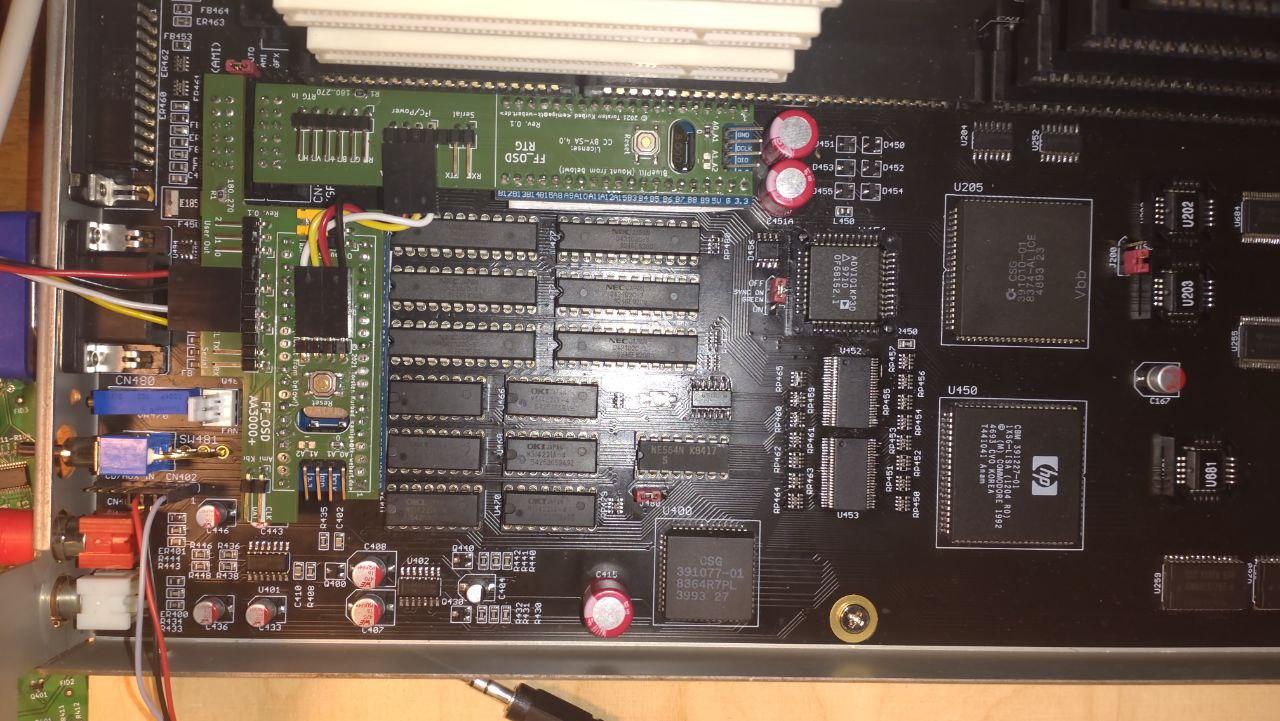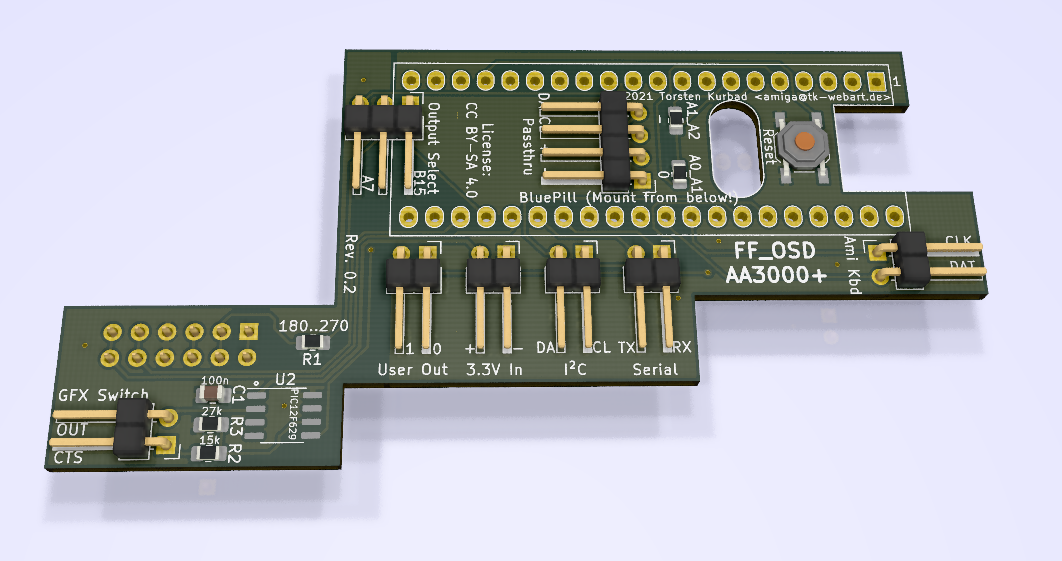I don't think it would be easy to drive two OSD outputs simultaneously, but switching between VGA and AGA modes on PA7 and PB15 respectively is more plausible. Do you need H/V syncs for both? Would need care picking the second HSYNC pin. Perhaps PA9 as this is a spare channel on Timer1 (existing PA8 pin uses T1Ch1, so using T1Ch2 would be not too hard to implement). Unfortunately this collides with the serial pins (useful for debug) but serial could perhaps be done on UART2 on pins PA2 and PA3.
In summary:
- Two built-in flash configurations. One for VGA, one for AGA.
- Hotkey to switch between the configurations.
- A bit of pin remapping for VGA so that independent Sync pin inputs are used, eg. H=PA9, V=PA11.
A further complication on (2) is that full mode switch usually requires a reset of the Blue Pill. Just because that's easier to implement and mode switches would usually be rare. So might need to fix that, or remember some state across reset.

Hi,
this will be a longer one, but bear with me!
I own one of those AA3000+ Amiga mainboards sold by user 'hese' on Amibay. I'm putting it into a Amiga 3000 case as it is supposed to.
While I want to equip the final setup with a FlashFloppy driven Gotek, I want to retain the original Amiga 3000 look. In particular, I don't want to alter the case in any way. So, FF_OSD controlled by the Amiga keyboard is the way to go.
The AA3000+ board has a built-in video switch that is able to switch the VGA output between two video sources. Usually one of those is the Amiga's AGA output and the other some kind of RTG card, in my case a 3DFX Voodoo3 PCI card.
I want to use the FF_OSD hotkeys to (a) switch between four Kickstarts as in the example in default_config.c by means of U0 and U1 and (b) to be able to manually advance the 3-position video switch to either "automatically" (1) switch between the two video sources or choose Amiga or RTG output manually. This should be accomplished by user pin U2 on the FF_OSD.
Also, I want the OSD to appear in both, the Amiga and the RTG output.
_(1) Automatic switching is accomplished by a piece of software called switchcontrol. It monitors the state of the graphics driver and drives the serial port's CTS signal low as soon as RTG output is desired. For automatic switching to work, CTS has to be jumpered to the input signal of the video switch circuit. If the jumper is removed and the switch input is left floating (or driven high), the output is fixed to the Amiga signal, if switch input is driven low, the output is fixed to RTG. On the mainboard, there's a pin header that has
CTS - SWITCH_INPUT - SWITCH_INPUT - GNDThus by connecting a on-off-on switch, you could switch between auto, Amiga, and RTG. One goal is to accomplish the same by a simple state machine driven by U2._In an initial working setup, I use two Blue Pills, connected in parallel to the Gotek's I²C port. One, the "master" plugs into the Amiga input of the mainboard and connects to the keyboard. It also has U0 and U1 switching by hotkey enabled as in the ROM switching example and U2 as a momentary button driven high by F10 on the keyboard. This Blue Pill has A0-A1 jumpered.
The second, let's call it "slave", Blue Pill connects to the RTG input on the mainboard and does not have A0-A1 jumpered. This way, the "master" receives all the Amiga keyboard commands and is able to control the Gotek, while the "slave" only receives the Gotek's output.
In my final working breadboard draft, U2 of the "master" egde triggers an interrupt of a PIC12F629 (which I happened to have laying around from another project). The PIC has an output connected to
SWITCH_INand a second input connected to the CTS output of the Amiga. Each detected low-to-high-edge of U2 advances the following state machine:To illustrate, here's my test setup (without the PIC12F629)
Rev. 0.2 of the "master board" integrates the PIC circuitry (and also has the cutout for the Blue Pill's oscillator corrected :-)
And here's a rendering of the much simpler "slave board"
While this setup works well enough, it has some drawbacks: (1) It uses two Blue Pills where only one might be necessary, given H- and V-Sync can be provided twice independent from one another, and SPI1 and SPI2 can be used as outputs simultaneously, one for RTG the other for Amiga GFX. (2) The PIC is very much of an overhead, because one additional input on the Blue Pill for CTS would suffice to implement the state machine therein. I just didn't like the idea of choosing one arbitrarily and starting to maintain my own fork of FF_OSD with this additional state machine. ;-) (3) The "slave" Blue Pill doesn't know anything about the Amiga keyboard. Thus, all the output associated with hotkeys is only visible while Amiga graphics input is chosen. In addition, only the "master" has the nice multi-line output that is triggered by jumpering A0 and A1.
So, the logical idea would be to consolidate all of this into a single Blue (or, if Blue is not powerful enough) Black Pill.
On a side note, this setup would be interesting for people using the so-called "Ratte-Switches" for switching between Amiga and RTG output and perhaps for other scenarios where you don't need the switching but have two different video outputs on the same machine.
Much of this behaviour could be made accessible through the configuration menu I guess (well, a man can dream... ;-)
@keirf What do you think about this proposal? Does it have the slightest chance of being possible to implement?